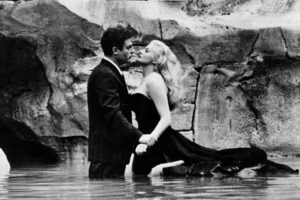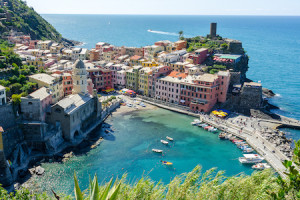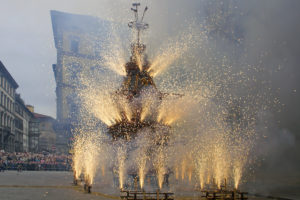Sometimes, when wandering around the backstreets of Rome, Florence, or any Italian city, you can come across unusual little things. Sometimes they’re not noticed until somebody points them out, but when they are, they’re intriguing. However, there’s often no signs or description to let us know what they are. So, just in case you’ve noticed them on previous trips, or if you want to look out for them on your next visit, here’s a few of the little curiosities of Italian cities.
Want to find some more unique little things to visit on your trip to Italy? Contact Us for a customised itinerary that can show you a different side to the country.
Florence’s Wine Doors
On many of the palazzos of Florence, there are small little arched windows – some with wooden covers, some now filled in – at the perfect height to pass as you’re walking past on the street. These are the buchette del vino, the wine doors, of Florence. At one time, these palazzos were owned by the rich banking families of the city, and they had various commercial interests, including vineyards outside the city. This meant they had plenty of wine, and so they might as well make a little more money from it. The windows are literal ‘hole in the wall’ taverns, where passers by could knock and order a cup of wine from the cellar manager. They could also order a demijohn or a barrel, and collect it at the palazzo’s service entrance.
Some of the windows are much more obvious than others, with signs saying ‘Vino‘ or ‘Vendita di Vino‘ (Wine for Sale). One good example, on Via delle Belle Donne, even has the opening hours listed above the doorway.
So next time you’re wandering the streets of Florence and pass one of these portals, it might remind you of wine – always a good excuse to find a nice little enoteca and sit with a good glass of Chianti!
Rome’s ‘Magic Door’
Not far from Roma Termini station, Piazza Vittorio Emanuele II is a pleasant, busy piazza with a nice park in the middle. There’s ancient Roman ruins of the nymphaeum of Alexander Severus – a former monumental fountain – and next to them a very curious structure. This is a stretch of wall with a filled in doorway, with strange symbols on the marble frame, and guarded by two imposing statues. This is what is known as Porta Alchemica, the Alchemical Door, or the Magic Door.
The door, and the wall it is on, is all that remains of the Villa Palombara, the grand residence of Massimiliano Palombara, who lived here in the 17th Century. According to legend, one night Palombara was the host of a pilgrim, who turned out to the alchemist Giuseppe Francesco Borri (aka Giustiniano Bono). Borri spent the night in the villa’s garden searching for a magical herb that would help him create gold. The next morning, he was seen disappearing through this door, leaving behind just a few flakes of gold and a parchment covered in alchemical symbols and equations, that was assumed was the secret to his successful experiment. Nobody could translate the symbols, and so Palombara had them carved around the door in the hope that somebody would one day figure out their secret. As yet, nobody has.
The statues on each side of the doorway actually have nothing to do with the story. They are Egyptian statues, of the god Bes, and were moved here in the late 1800s. But they suit the location.
The Pink Columns of Venice’s Doge’s Palace
The Doge’s Palace in Venice is one of the most impressive buildings in the city. It’s rows of columns are architecturally and aesthetically beautiful. Look a little closer though, and you may discover an anomaly. While most of the columns are white, there are two random pink ones on the end closest to St. Mark’s Basilica. Did they run out of white columns while building it? Nope. Was it a mistake? Nope. The truth is a little more grisly.
Between these columns is where the Doge would stand to give official announcements, and some of these official announcements were often death sentences for criminals. Sometimes the condemned men were aristocrats, and they were hanged right in this place. This happened to Bartolomeo Memmo, who had conspired against the Doge. In 1470, he was hanged between the two pink columns, and his body left there for several days as a warning to others. The common people were executed between the large columns of the Square, the ones topped by St. Mark and the Lion of Venice, and so it is believed to be bad luck to walk between them.
The ‘Devil’s Column’ of Milan
The Basilica of Sant’Ambrogio is one of Milan’s main churches. It was founded by Saint Ambrose, the patron saint of Milan, and his body is in the church to this day. Many visitors come to the basilica every day, but most probably miss an interesting curiosity that is just outside the main building. This is an ancient column, with two holes towards the bottom, and the story of how they got there is one of Milan’s little legends.
According to local legend, Saint Ambrose was walking in the gardens of the basilica one day (at that time the church wasn’t named after him, but was called Basilica Martyrum, after the martyrs who had died on the site). He was well known as a leader of the Christian community, and one of the main bishops in Italy, and so tradition says that he was the focus of a lot of attention from the Devil himself. The Devil kept trying to corrupt Ambrose, and did so again on this day. He tried to tempt Ambrose into sin, but the bishop wasn’t interested. The devil, out of frustration at his inability to corrupt this church leader, hit his own head onto a column so hard that he ended up getting his horns stuck. He was stuck for a day and a night, until he disappeared in a puff of sulphuric smoke. Locals say that if you smell the holes, the scent of sulphur still lingers.
Tuscany’s Sword In The Stone
When the Sword in the Stone is mentioned, most people would automatically think of the legend of King Arthur, set in Dark Ages Britain. So it seems rather odd to have a real life sword in the stone in a medieval chapel in Tuscany, and yet there is one.
Montesiepi Chapel is close to the town of Chiusdino, not far from Siena. The chapel was built on the site of the hermitage of Saint Galgano. Saint Galgano was a Tuscan knight who had visions, first of the Archangel Michael, and then of Christ and the Apostles. On the site of his second vision, on the hill of Montesiepi, Galgano wanted to set up a cross, but had no way to make one, and so he drove his sword into the ground instead. The sword immediately became part of the ground, and nobody could remove it.
The sword still exists, protected by a perspex case, still in the ground inside the Chapel of Montesiepi, which was built over the site after Saint Galgano’s death. Close to the sword is a rather grisly relic – two arms. It is said that these were the arms of an attempted thief who tried to remove the sword. The thief was attacked by a wolf, who devoured every part of the man except for his thieving hands and arms – a warning to everybody else not to attempt to steal the sword.
Intrigued by some of the unique little stories? Discover more on some wonderful tours that we can arrange for you all over Italy. Contact Us to discuss your perfect Italian experience.









Leave a Reply
Thank you for your comment!